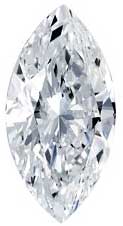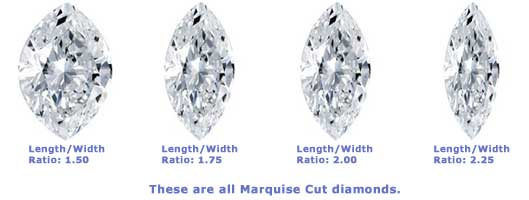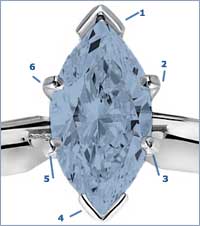 The marquise cut diamond (also called, the "navette" cut diamond) is an elongated shape with pointed ends.
The marquise cut diamond (also called, the "navette" cut diamond) is an elongated shape with pointed ends.
The cut was developed for France's Louis XIV who, so enchanted by the fetching smile of the Marquise de Pompadour,
commissioned the development of a diamond to match the smile.
The marquise cut is gorgeous when used as a solitaire or when surrounded by smaller diamonds and gemstones.
Choosing a Marquise Cut Diamond
When purchasing a marquise cut diamond online, be sure to check width and length. The length/width ratio is the number
that tells you how "skinny" or "fat" the diamond is when viewed from the top.
For a traditional marquise cut, select a diamond in that falls in
the 1.75 - 2.25 length/width ratio.

Our minimum recommendations for buying marquise cut diamonds are as follows (please remember these
recommendations are opinion only, and your tastes may vary):
- Cut: Good
- Color: H
- Clarity: VS2
- Depth Percentage: 57-69%
- Table Percentage: 51-65%
- Length-Width Ratio: 1.75 - 2.25
Marquise Cut Diamond Engagement Ring
While not the traditional selection, marquise cut diamonds are an
elegant stand out from the more common round brilliant generally
selected for engagement rings (either as a solitaire or with accent
stones).
 Marquise cut diamonds require specialized settings — particularly with added prongs to protect the points of the diamond.
Marquise cut diamonds require specialized settings — particularly with added prongs to protect the points of the diamond.
Hand-Selected Marquise Cut Diamonds
 To give you some ideas of what's available for a marquise cut diamond
ring, we've preselected a range of certified marquise cut diamonds for
you to
examine . Except for the "Bargain Basement" selections, these diamonds are within
our minimum requirements as listed above and are suitable for solitaire settings or settings with accent stones.
To give you some ideas of what's available for a marquise cut diamond
ring, we've preselected a range of certified marquise cut diamonds for
you to
examine . Except for the "Bargain Basement" selections, these diamonds are within
our minimum requirements as listed above and are suitable for solitaire settings or settings with accent stones.
No comments:
Post a Comment